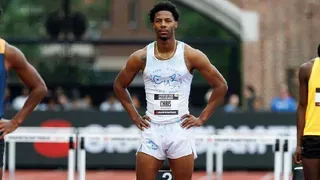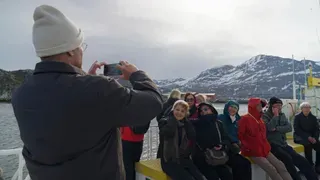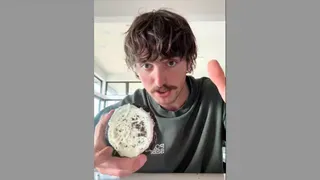December 20, 2010
Miami and the Beaches During Art Basel Madness
Michael K. Lavers READ TIME: 6 MIN.
Call him the beau of the ball!
The New York Times described Brazilian artist Ernesto Neto's "Circleprototemple" as "Cinderella's carriage after midnight, if it had turned into a strawberry instead of a pumpkin." This installation, which is wrapped in red nylon and contains a drum inside that symbolizes a beating heart, certainly entertained this reporter and others who attended Art Basel Miami Beach on Dec 2-5.
More than 250 galleries from around the world showcased Pablo Picasso, Marc Chagall, Andy Warhol, Jackson Pollock, Joao Mir�, Keith Haring, Amy Bessone, Roy Lichtenstein and others at the Miami Beach Convention Center (1901 Convention Center Drive).
Chilean painter Claudio Bravo's homoerotic depiction of a young Moroccan man wearing only a pair of soccer shorts in "Noureddine" drew more than a few lustful gazes at the Mary-Anne Martin/Fine Art exhibit. Jim Lambie's "Bhangra Remix" evoked some Disco-era nostalgia with its glittery gold turntable and stiletto heels and gaudy women's jewelry that dangled beneath it. And the twenty black and yellow flippers fused together "Patas de Rama Negras" proved that Los Carpinteros understand simple symmetry - while producing particularly interesting art.
Indonesian painter Nyoman Masriadi's "Tragedy" provides a stark and disturbing glimpse at the human condition, but Mount Merapi's eruptions in late October and early November nearly forced the artist to cancel his Art Basel exhibition. The volcano, which killed hundreds of people on Java in late October and early November, forced Masriadi to evacuate his studio - he signed and dated "Tragedy" on Nov. 22.
On a far more light-hearted note, Nick Cave's futuristic "Soundsuit 2010" evoked an era of space age junkets to the moon. Gay artist Kehinda Wiley's life-like portraits of young men of color certainly captured this reporter's imagination, but some Art Basel attendees literally used the clothes on their backs to make an artistic statement.
One middle-aged woman with a petite figure of someone more than half her age used plastic neon skeletons to accessorize her punk-era patent leather suit - and the oversized beaded bracelets she wore would have certainly made Lady Gaga proud. Several members of Palm Beach (and S�o Paolo, Rio de Janeiro, Buenos Aires and Madrid) society also donned their finest designer suits and shoes to peruse the exhibits. Some the more memorable fashion statements, however, were made outside the Convention Center.
An Al Fresco Catwalk
Sushi Samba (600 Lincoln Road) provided the perfect post-Art Basel vantage point to watch South Beach's models, glitterati and otherwise beautiful people strut their stylish-and surgically enhanced-stuff under the warm South Florida sun. One particularly stunning Latina perfected the art of coordinating shin-high argyle socks with her hot pants - while a steady stream of gym bunnies had no problem showing off their perfect pecs and chiseled abs along Lincoln Road. And the Estonian waiter at Sushi Samba provided some additional eye candy.
The Palace Bar and Restaurant (1200 Ocean Drive) provided yet another strategic venue to survey South Beach's glamorous street scene while enjoying a refreshing mojito (or two). The energetic Bacardi shot girls did their best to enhance their thirsty customers' libations on Saturday, Dec. 3, but this reporter was far more interested in the Speedo-clad volleyball players across Ocean Drive in Lummus Park and the cute Latino shot boy serving customers on the sidewalk. Sorry ladies!
Pink Snails Invade South Beach
Subtle is an adjective not typically used to describe Miami, but the various public art installations discreetly (or not so discreetly) scattered throughout the area complemented Art Basel quite nicely.
The Cracking Art Group and La Galleria ca d'Oro installed 45 pink snails along the Venetian Causeway between Miami and Miami Beach, in Lummus Park, along Alton Road, and even in hotel lobbies as a way to raise awareness about recycling. The exhibit runs through Jan. 3.
Across Biscayne Bay in Miami's Design District, Friends with You's Rainbow City featured forty inflatable installations in a vacant lot on NE 39th Street inspired by Holi, a Hindu festival at which participants throw brightly colored water and powder at each other.
OHWOW's It Ain't Fair 2010 exhibition on NE 40th Street showcased avant-garde artists and photographers, while the Haiti Art Expo 2010 in the nearby Mosaic Building (161 NE 40th St.) highlighted Haitian artists-100 percent of the sale proceeds go to those who lost their homes in the earthquake that devastated large swaths of the impoverished Caribbean country in January.
Miami’s Main Street
Dubbed Miami's Main Street, Biscayne Boulevard contains additional public art installations that showcase the city's cultural and architectural affinity with Latin America and even Spain.
The undulating red and gray sidewalks along Biscayne Boulevard between the Adrienne Arsht Center and SE 2nd Street resemble those that Brazilian architect Roberto Burle Marx installed along Copacabana Beach in Rio de Janeiro in the late 1980s. The Freedom Tower (600 Biscayne Blvd.), with its yellow fa�ade, resembles the Giralda in Seville, Spain. And the botero and tea cup sculptures adjacent to the American Airlines Arena provide interesting diversions for anyone waiting for a Miami Heat game to begin (or longing for an escape from the Lebron James fever that continues to rage across South Florida.)
The iconic neon rectangle that outlines Marquis' multi-story penthouse (1100 Biscayne Boulevard) cements the development's place on the Miami skyline; it is clearly visible from the MacArthur Causeway and on South Beach.
The Tempo Miami is a 57 room luxury hotel within the same Arquitectonica-designed building. Rooms, which start at $335 a night, overlook the future Museum Park, the Port of Miami and Biscayne Bay. And while the location can prove particularly challenging for those without their own transportation, the hotel - and especially the deep soaking tubs in each room and the 8,000-square foot spa and fitness center - did provide a welcome escape from Art Basel's hustle-and-bustle.
Amuse on Tempo's third floor is a great space for young Miamiams to pre-party before they revel downtown or on South Beach (Orietta's stiff cocktails infused with tropical fruit juices and exotic liquors are particularly good).
Amuse's small plates concept complements its signature cocktails nicely. The pumpkin gnocchi with roasted chanterelle mushrooms and spiced brie, the inside-out BLT and the fried goat cheese with pistachio pesto are particularly savory choices.
South of the Miami River, Mary Brickell Village has become an increasingly popular place for Miamians to party and/or to be seen. Snooki and her BFFs from the Jersey Shore would have certainly felt right at home at the Viceroy's Club 50 (485 Brickell Ave.) The pool deck and lounge afford sweeping views of Miami and surrounding areas, but the competing DJs can prove too much for even the most adamant fist pumper. The Viceroy's lobby, with its turquoise and jewel encrusted furniture, ultra-modern light fixtures, tropical hardwood paneling and marble floor, provides an additional artistic statement for those who may have already seen it all (or think they have seen it all) in Miami.
Based in Washington, D.C., Michael K. Lavers has appeared in the New York Times, BBC, WNYC, Huffington Post, Village Voice, Advocate and other mainstream and LGBT media outlets. He is an unapologetic political junkie who thoroughly enjoys living inside the Beltway.






